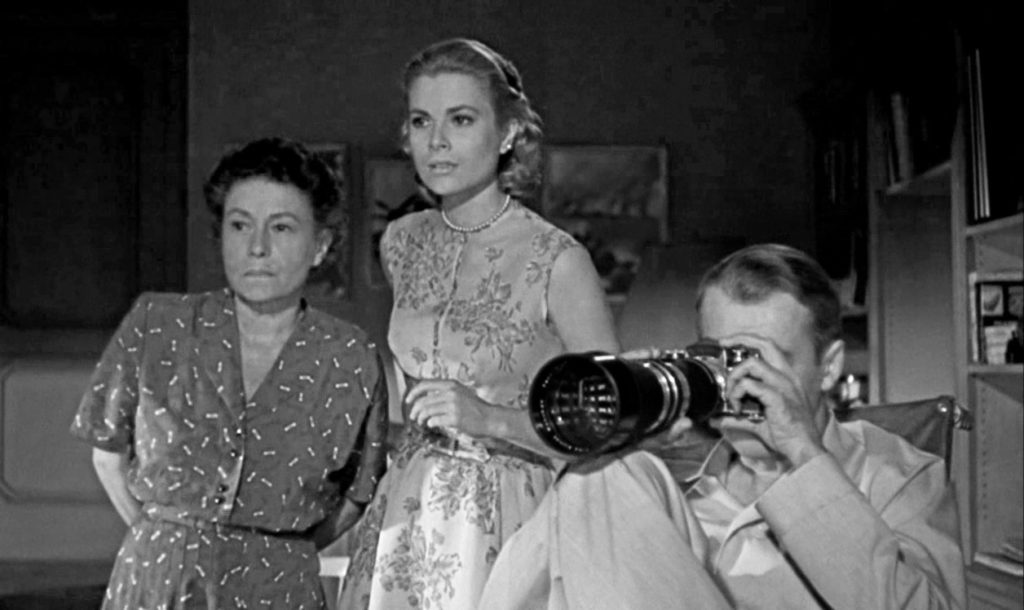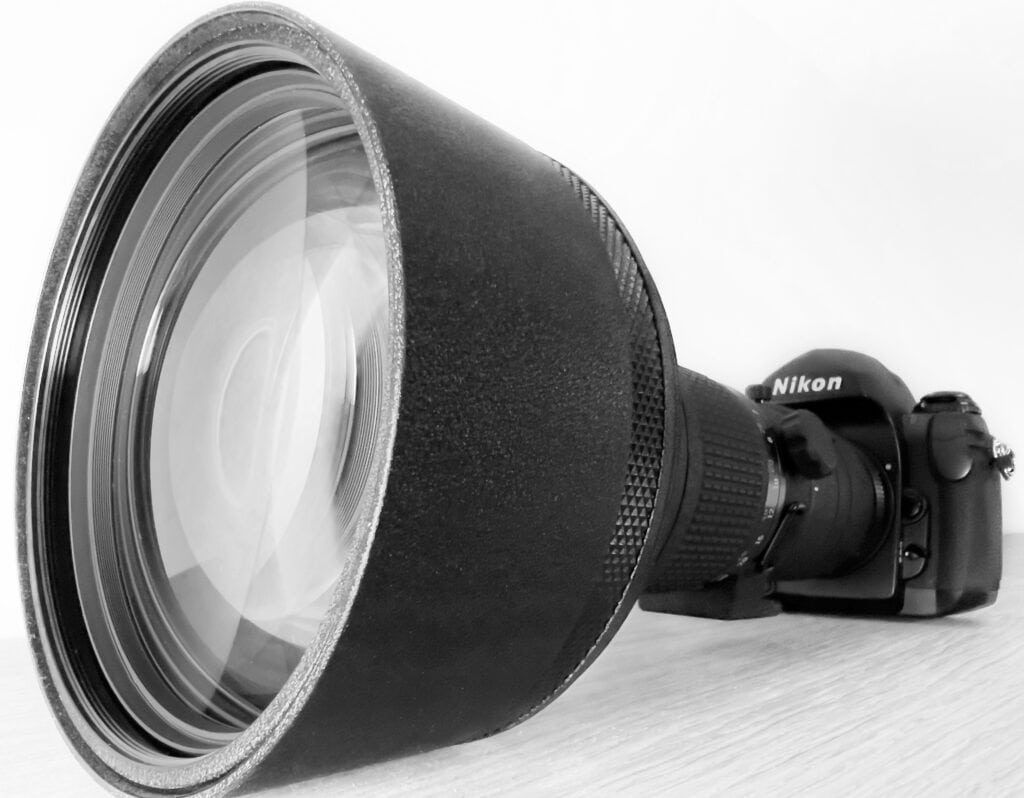This article was inspired by classic film cameras in movies – specifically , Leicas and Nikons. From cameras in movies, it’s a short step to movies about photographers. My favourite movie with a photographer as the lead character is Alfred Hitchcock’s Rear Window, and I was intrigued by the camera and telephoto lens Jimmy Stewart used in the role – hence this article.

Rear Window
Alfred Hitchcock’s Rear Window contains probably the most iconic photographer/film camera combinations in movie history. The film is based on a short story, “It Had to Be Murder” and stars Jimmy Stewart as LB ‘Jeff’ Jeffries, a New York magazine photographer. Recuperating from a broken leg, Jeffries is confined to a wheelchair in his apartment in Greenwich Village.
Jeff’s rear window looks out onto a courtyard and his neighbour’s apartments, which he observes during his convalescence in a stifling Manhattan summer. The include a lonely middle-aged woman, a new wed couple, a dancer, a husband and his sick wife, an alcoholic pianist and a couple who often sleep out in the balcony in the hot weather. Jeff’s observations include some suspicious sounds and behaviour and he becomes convinced one of his neighbours, Lars Thorwald, has committed a murder.
Inspirations for a Murderer
Mischievously, Hitchcock modelled the murderer on a former meddling producer he did not care for, David O. Selznick. Grace Kelly plays the archetypical Hitchcock blonde heroine in Lisa Carol Fremont, a stylish and resourceful socialite who has to engage in much of the action as Jeff is wheelchair bound. Although he did not write the the screenplay, Hitchcock also supplied colour for the murder story from two cases he head read about in the newspapers: the infamous Dr. Crippen and the less well remembered Patrick Mohan, both of whom dismembered their victims.
The Role of the Photographer
Rear Window is another of my favourite films, and the role of the photographer is pure Hitchcock. David Campany describes it well in the essay Re-viewing Rear Window:
“For Hitchcock’s purposes, a photographer is above all someone who looks. It is their socially accepted voyeurism that is significant, not their images. Voyeurism requires a safe distance, a vantage point for the observer beyond the reach of the observed (much like a movie audience, watching but not accountable). In Rear Window, the photographer is cut off not just by the lens of his camera, or by the glass window of his apartment, or indeed by the abyss of the courtyard across which he stares. It is his professionalized looking, with its fantasy of objectivity, that cuts him off. It demands his separation from the world. Despite witnessing what he believes is a murderer covering his traces, he feels no urge to get it on film. Rather, he uses his camera’s long lens as a telescope to watch, swapping it for binoculars when things get really intense.”
That Obscure Object of Desire
Jeff’s camera was an Exakta Varex VX 35mm film SLR made by the improbably named Ihagee of Dresden, which was in East Germany at the time. This manufacturer is best known for the Kine Exakta (1936-1948), the first 35mm single-lens reflex (SLR) camera in regular production.
The Exakta Varex VX was introduced in 1951 and was based on the Kine Exakta. The Exakta Varex VX was a system camera that could be used with either a waist level finder or with a pentaprism and a variety of focusing screens. Other specialised equipment available for the camera system included microscope adaptors, extension bellows, stereo attachments and medical attachments.
Exakta as Witness
In addition to a staring role in Rear Window Josef Koudelka used an Exacta Varex to photograph the invasion of Prague in 1968. He had returned to Czechoslovakia from Romania recording his photo-essay Gypsies (also with an Exacta Varex) two days before the Soviet invasion of Czechoslovakia in August 1968.
These photographs, of crowds staring down the barrels of tank guns, defiant youths waving resistance flags in smouldering streets and anti-Soviet graffiti that sprang up every day and was whitewashed every night, came to define one of the pivotal moments of 20th-century history. However Josef Koudelka would have to wait another 16 years for an exhibition at London’s Hayward Gallery before being credited as the photographer. Until then, the pictures had been attributed to PP (Prague Photographer) to protect Koudelka and his family from reprisals. Josef Koudelka: the lonely, rebel photographer
Rear Window
In Alfred Hitchcock’s Rear Window the Exakta Varex VX was paired with a huge 400mm telephoto lens; the catchily named Kilfitt fern-kilar f/5.6 model. The f/5.6 400mm lens weighed 1.76kg and almost certainly required a tripod to obtain sharp shots.
Collectively the camera/lens combination is known as the ‘Rear Window stalking camera’ and is much desired by collectors.
Although scarcely known today beyond its association with the Hitchcock classic, Kilfitt was an innovative German lens manufacturer who introduced the first production varifocal (zoom) lens for still 35mm photography – The Zoomar of 1959, which arrived the same year as the Nikon’s game changing F. Kilfitt also produced the first macro lens to provide continuous close focusing in 1955. If you are interested in photography milestones such as these, take a look at the timeline on this site.
My Own 400mm Rear Window Lens

I have a 400mm lens prime also. Not wanting to spend several thousand on a lens I would use only occasionally I purchased an old school manual focus Nikon Ai-S 400m f3.5 IF-ED from a Japanese eBay seller.
A Beast of a Lens
It’s an all-metal 2.8kg beast of a lens, a whole 1kg heavier than the Rear Window 400mm, and built like the proverbial tank. Mine came with a protective clear 122mm filter, which made it even better value. It is an amazing piece of kit but not the most practical. There’s no VR and it requires a tripod and a gimbal head, which makes the combined shooting weight pretty substantial.
The first version of the lens was introduced in 1976 and was followed in 1977 by an Ai version. Mine is the Ai-S lens version introduced in 1982 and which can be identified by the minimum aperture number which is engraved in orange. The expression ‘they don’t make them like that anymore’ was never more true than with this lens which is an incredibly solidly engineered piece of work.
I used it originally for shots of the moon with the Z7 and the FTZ adapter using focus peaking, but I have recently acquired the new 100-400 mm zoom for that kind of shot. It’s better optically of course, and far lighter, but has nothing like the presence. I’ve kept the old monster for use with my older Nikon cameras – the F series and FM film classics. Sometimes, only film will do.
Other Movies Featuring Photographers
Whilst my favourite movie with a photographer as lead is Rear Window, but there are many others featuring photographers. My favourite is Apocalypse Now – the subject of another article on this site, but here’s a list of some of the most notable of the others.
- Blow-Up (1966)
- Double Exposure: The Story of Margaret Bourke-White (1989)
- Proof (1991)
- The Killing Fields (1991)
- High Art (1998)
- Pecker (1998)
- Harrison’s Flowers (2000)
- Gentlemen’s Relish (2001)
- City of God (2002)
- Closer (2004)
- Fur: An Imaginary Portrait of Diane Arbus (2006)
- Everlasting Moments (2008)
- The Secret Life of Walter Mitty (2013)
- Kodachrome (2017)
- Photograph (2019)